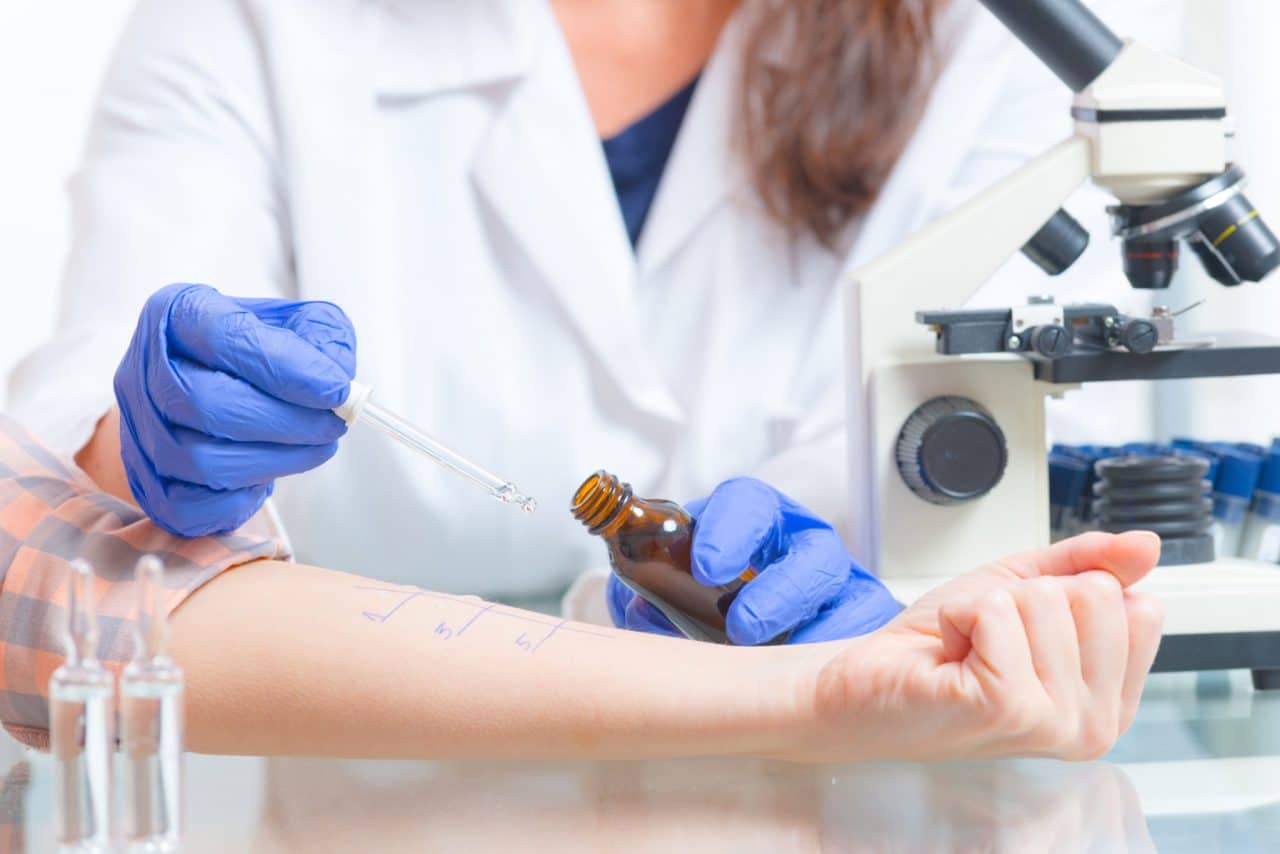The best way to treat your allergy symptoms is to schedule allergy testing to determine their exact cause.
Skin Prick Testing
Skin tests are the preferred allergy test because they are safe, affordable and they provide accurate results.
How Does a Skin Test Procedure Work?

In prick testing, several drops of a solution containing the suspected allergen are placed on the surface of the skin. A needle is used to prick or scratch the skin where the drops are placed.
If your body is allergic to this substance, the immune system will respond. The result is swelling and redness on the skin.
How Fast Are the Results of a Skin Prick Test?
This allergy testing procedure is performed in-office and should take no longer than 20 to 40 minutes. Skin prick test results are available before you leave the doctor’s office because skin prick tests are visual. With a prick test, an allergist can tell whether you are allergic to an allergen based on how your body responds.
Prick testing is safe and reliable. This test may cause minor discomfort, swelling or itching. It is most often used to test for allergies to pollen, mold, dust mites, pet dander and food.
Skin Prick Test vs. Patch Test
A patch test is more often used to identify allergens that cause skin rashes. Patch tests typically take several days to process and function differently. Where a skin prick test introduces a tiny amount of an allergen into the skin, a patch test holds a liquid containing the allergen on top of the skin using a specialized patch. After 48 hours, the patient can return to the allergist, who will then mark the test sites and a third appointment may occur another 48 hours later before final results can be determined.
Intradermal Test
An intradermal test is used when a skin prick test does not produce an allergic reaction. An intradermal wheal, or bleb, is injected directly under the top layer of skin. After 15 minutes, any reactions are measured and classified as either positive or negative.
Blood Testing for Allergies
A blood test measures how much of an allergen-specific antibody, called immunoglobulin E (IgE), is in your blood. The more allergen-specific IgE in your blood, the more likely you are to be allergic.
The most common blood test is a radioallergosorbent (RAST) test. It screens for common allergy triggers such as pollen, mold, dust mites and pet dander. RAST is the preferred testing method for infants and children. It is less expensive and results take longer since an outside lab is involved.
Blood tests are typically used to confirm the results of a skin test; they may also be used instead of skin tests if a serious allergy makes skin testing unsafe.
When Is Blood Testing Preferred Over Skin Testing?
Some medications and conditions make blood testing preferable because blood testing doesn’t expose a patient to allergens. Medicines on that list include antihistamines, steroids and antidepressants. People with life-threatening allergies, skin conditions, asthma or heart conditions may all be better candidates for a blood test.
Pulmonary Function Tests
Pulmonary function tests are used to determine how well your lungs are working. They are typically completed in addition to allergy tests. The three main tests are spirometry, plethysmography and diffusion capacity. Spirometry measures the amount of air you breathe in and out by breathing into a machine. Plethysmography measures your lung volume, or the amount of gas in your lungs, by having you stand in a small booth and breathe into a mouthpiece. The diffusion capacity test evaluates how well the small air sacs within your lungs work by having you breathe in certain gases and breathing out into a machine.
Food Allergies
Your immune system’s primary goal is to keep your body healthy. In the case of food allergies, your immune system mistakes harmless food proteins as a threat and attacks. Large amounts of immunoglobulin E (IgE), an antibody, are produced. IgE causes the release of histamine and other chemicals, which can trigger the symptoms of an allergic reaction.
How Are Food Allergies Diagnosed?
Food allergies can be diagnosed through a blood test. A blood test is used to measure the amount of allergen-specific IgE antibodies present in the blood.
If blood testing is negative, an oral food challenge can also be performed in order to rule out a food allergy. This test takes place in the clinic where you will be under constant medical supervision. This ensures if you experience an allergic reaction it can be treated immediately.
The food in question is ingested in small amounts and the challenge is stopped at the first sign of a reaction. After a few hours, if no reaction has occurred, you are not allergic.
How Are Food Allergies Treated?
If the cause of the allergy symptoms cannot be determined, an elimination diet is recommended. Potential trigger foods are eliminated from your diet for a few weeks. If the symptoms resolve, the eliminated food is most likely the culprit. To make sure, you may be asked to reintroduce the food back into your diet to see if the symptoms return.
A food allergy should not be taken lightly. The best way to stay safe is to know exactly what can cause a reaction and to have a treatment plan in place. The doctors at Nevada Ear + Sinus Institute have the tests needed to determine what you are allergic to.
Call Nevada Ear + Sinus Institute at (702) 735-7668 for more information or to schedule an appointment.